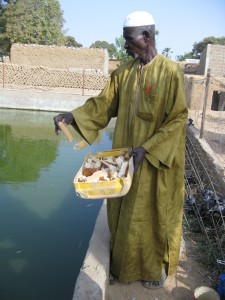CRSP Research Increases Agricultural Productivity
Achieving increases in productivity, defined as deriving greater output per unit of input, is a central feature of USAID-funded agricultural programs and particularly the work of the Collaborative Research Support Programs (CRSPs). Productivity gains can come from improvement in breeding, from changes in cultivation practices, and from reducing losses post-harvest. Productivity per unit of labor can be improved through the use of more efficient tools.
Collectively, the CRSPs contribute significantly towards increasing agricultural productivity while raising producer incomes and improving the natural environment. A few recent examples include the work of the AquaFish CRSP which has developed higher yielding sustainable rice-fish ponds in Mali. Using a different approach in the Philippines, AquaFish researchers have helped to reduce the cost of supplemental feed by developing alternative feeding regimes. The options included delaying until the fish are older to start the feed, feeding less than typically recommended amounts, or feeding 100% of feed but only on alternate days. These techniques have helped fish farmers to save money while maintaining production levels.
The SANREM CRSP is working in western Kenya and eastern Uganda on conservation agriculture techniques to arrest soil degradation and erosion and ultimately to reverse declining yields of maize and beans.
Plant crop yields are being increased through the work of the Pulse CRSP, which combines conventional and molecular approaches with participatory farmer research to increase resistance to both biotic and abiotic stresses in beans in Ecuador and Rwanda. The Peanut CRSP has used traditional breeding methods to achieve higher yields of groundnuts in Uganda by creating resistance to the Rosette Virus, adding an estimated US$50 million in farmer incomes. INTSORMIL has successfully launched new, higher-yielding varieties of sorghum in Central America for use as cattle fodder and has helped breed Striga-resistant varieties that have been released through national programs in Africa.
New technologies often prove to be the pathway towards higher and more secure harvests. The IPM CRSP is testing ecologically-based IPM techniques to raise the productivity of high-value horticultural crops in East Africa. The Horticulture CRSP is promoting the Coolbot™, an inexpensive option for creating cold storage for fruits and vegetables.

